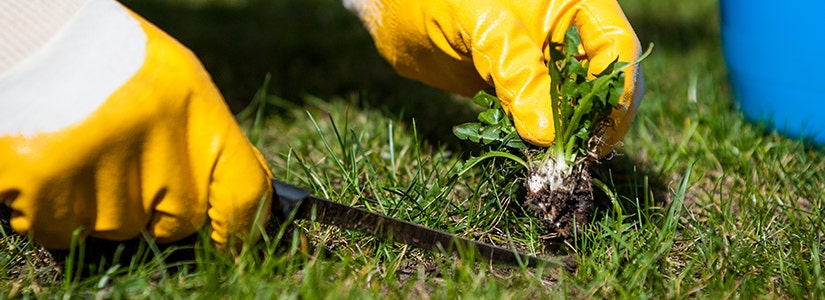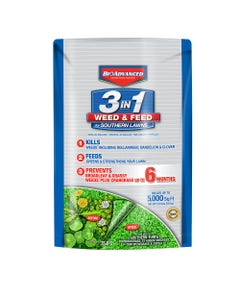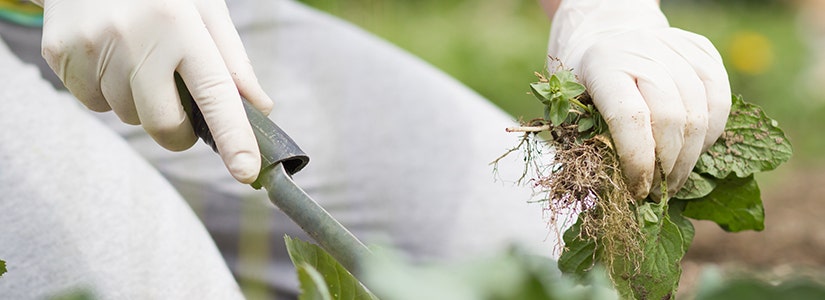

- Home
- Solution Center
- Learn
- Lawn and Landscape
- Top Strategies For How To Get Rid Of Weeds
Top Strategies For How To Get Rid Of Weeds
Know The Enemy
Eradicating weeds isn't a task for the fainthearted. It requires elbow grease, persistence and a little intelligence. In order to know your best method to kill any particular weed, you need to understand it — how it grows, when it grows and the best time to attack it. Improve your odds of success by adopting some of these clever, and easy, weed-killing strategies.
Annual Weeds
From the moment annual weeds sprout, they're racing to flower and set seed. Your job is to interrupt the process. If you can't kill weeds or pull them shortly after they appear, make sure you deal with them before they set seed.
If they set seed, mowing with a grass-catcher bag attached is a way to cut and collect seeds before they drop. This method works well with grassy lawn weeds, such as Quack Grass and Goosegrass. Rake weeds before mowing to pull seed stems upright. After mowing, destroy or dispose of seeds – don't add to your compost pile. Be careful not to rake if seeds are dropping, or you risk spreading seeds.
Perennial Weeds
As soon as perennial weeds sprout, it's time to take action. With tap-rooted weeds such as Dandelion, pulling young plants improves your odds of removing the entire root.
If you miss this opportunity, you'll need to kill mature tap- or tuber-rooted or perennial weeds by consistently removing or treating foliage with herbicide as it appears. For grassy weeds such as Nutsedge, treat before six leaves appear. For broadleaf weeds, treat when leaves have just unfolded, but before they have time to start replenishing root stores.
If you use this technique on Dandelions, you'll wipe out most plants with two treatments. With more stubborn weeds, this process could continue for multiple seasons, but don’t give up! Every time the plant pushes out new leaves that are killed, that effort is depleting food supplies in the root. At some point, food reserves will run out, and the plant will die.
Killing Weeds: Pulling vs. Spraying
Pulling weeds by hand is realistic when you're dealing with a small area or just a few weeds. Weeds come up easiest when soil is moist and plants are small. If rain is scarce, water about 24 hours before weeding, soaking soil 6-12 inches deep.
Make sure you remove roots. With many perennial weeds, root pieces left in soil will sprout. Dandelion roots can extend to 24 inches deep, but most plants have roots 6-18 inches long.
Spraying herbicide plays an important role when you're clearing vegetation from an area, are dealing with a large number of weeds or weeds you can't eradicate any other way.
Prevent A Problem From Sprouting
Don’t let weeds gain a foothold. Use a pre-emergent herbicide to prevent weed seeds from germinating in planting beds and lawns. Don't use pre-emergent weed killers in beds where you plan to sow seeds – the herbicide may prevent your seeds from germinating as well. Apply a layer of mulch to keep weeds from sprouting. In planting beds, a 2-inch-thick mulch layer can suppress weeds, as can tightly-spaced plants, which don't give weeds the necessary elbow room, or sunshine, to survive.
Timing Is Critical
Attack weeds early in their growing seasons when growth is young and small. Don't let annual weeds flower. If you don't have time to pull plants, just yank blooms as they appear until you can finish the job.
If flowering does occur, don't let plants disperse seed. One Dandelion produces an average of 15,000 seeds, which can live up to six years in soil; one Curly Dock plant produces 100-60,000 seeds, which can survive as long as 17 years. Allow one plant to cast its seed, and you'll discover the truth of the gardening adage, "One year's seeding means seven years' weeding."
In early spring or late fall (even after hard frost), perennial weeds can appear green, which may tempt you to apply herbicide. Don't be fooled. When temperatures are low, plants aren't actively growing. During summer’s hottest days, some weeds become dormant as well. Treating weeds with herbicide during dormancy is a waste of time and money. Watch for new leaf formation. That's the clue to active growth – and the cue to fill your sprayer. For many perennial weeds, such as Dandelion or Bermudagrass, a late summer/early fall spray – just before plants enter dormancy – can prove effective. The chemical is transported to roots, which results in complete kill.
As some weeds, such as Crabgrass, mature, the leaves develop a hard coating that actually sheds herbicide. Even though the plant is actively growing, the herbicide can't penetrate leaves. Crush or crumple leaves of mature weeds to ensure herbicide penetration. If you're dealing with a patch of weeds, beat plants with a bamboo stake to tear leaves before spraying.
Tools
Specialized weeding tools do make it easier to remove weeds. Hoes wipe out young seedlings quickly, as do tined cultivators. Short knives fit between paver stones. Dandelion weeders work like a charm. Investigate weeding tools at garden centers or online to discover the right tool for your weedy situation.
If you choose to use a herbicide, be sure it’s labeled for the weed you're attacking. Also check that the weed killer won't harm your grass or surrounding plants you want to keep. Always read and follow label instructions carefully. To learn more about the different types herbicides, read Killing Weeds: Begin With The Basics.
Additional Tips
Here are some more things you can do to get the best results from your weed-killing efforts.
- Create a spray zone by removing both ends of a can or the bottom of a 2-liter plastic bottle. Slip the container over the weed, insert the sprayer nozzle through the top opening, and spray. Use an open-ended cardboard box to target a larger weed patch.
- To spray one weed growing in the middle of desirable plants, cut a small hole in a large piece of plastic. Lay the plastic over the weed, pulling the leaves through the hole. Apply weed killer. Wearing gloves, remove the plastic after the herbicide dries. Handle plastic carefully to avoid dripping herbicide on cherished plants.
- Get pinpoint accuracy by using a paintbrush or glove to apply herbicide to specific leaves. If using a cotton or other type of porous glove, wear a plastic glove beneath it to avoid herbicide contact to skin.
- To spray weedy vines without harming garden plants, follow a step-by-step attack. First, cut the plant at soil level and insert a short stake near the base of the vine. When the vine resprouts, it will start to climb the stake. Before growth exceeds stake height, slip an open-ended plastic bag over the weed. Remove the stake, and spray the weed inside the plastic bag. Don't remove the bag until herbicide has dried on foliage.
- If you accidentally splash herbicide on desirable plants, wash leaves immediately with water. If you are using systemic herbicide, prune affected plant parts immediately and wash remaining leaves with water.
After The Weed
Weeds are opportunists. Leave one bare spot, and multiple weeds will likely appear. Once you've dealt the deathblow to a weed, either by pulling, digging or spraying, fill in any resulting bare spot with mulch or seed. If you're seeding, loosen but don't turn existing soil, cover it lightly with compost and sow seed.

















